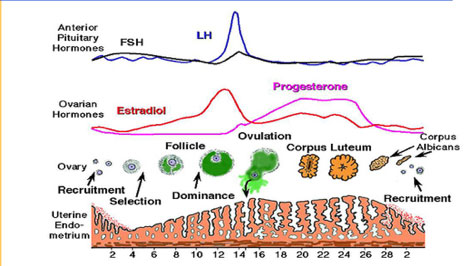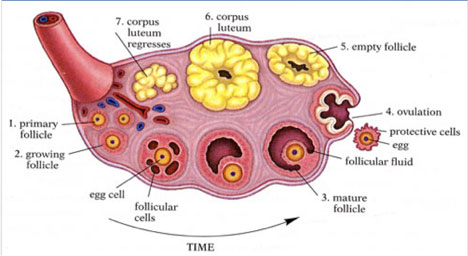At the top of the figure are the anterior pituitary hormones, FSH and LH. The figure depicts the rise and fall of estrogen and progesterone at various phases of the menstrual cycle. The changes in the ovaries are also shown. At the bottom of the figure, the changes in the lining of the uterus (endometrium) at various phases of the menstrual cycle are illustrated.
In the follicular phase of the cycle, FSH levels increase and the recruited follicles produce increasing levels of estrogen. Estrogen stimulates the lining of the uterus to thicken (proliferate) in preparation for implantation of an egg should pregnancy occur. The rising estrogen levels, along with a hormone called inhibin-B, have a negative effect on pituitary FSH secretion. These hormones will bind to the FSH receptors in the pituitary gland and decrease production of FSH.
As ovulation approaches, the blood supply to the ovaries increases and the ligaments contract, pulling the ovaries closer to the fallopian tubes, allowing an egg, once released, to find its way into the tube. Just before ovulation, a woman’s cervix secretes an abundance of clear “fertile mucous” that is characteristically stretchy. Fertile mucous helps facilitate the sperm’s movement toward the egg. Some women use daily mucous monitoring to determine when they are most likely to become pregnant. Mid-cycle, some women also experience cramping or other sensations. Basal body temperature rises right after ovulation and stays higher by about .4 degrees F until a few days before the next period.
Inside the fallopian tube, the egg is carried along by tiny, hairlike projections called “cilia” toward the uterus. Fertilization occurs if sperm are present. A tubal pregnancy, called ectopic pregnancy, is the rare situation when a fertilized egg implants or gets lodged outside the uterus. It is a dangerous and life-threatening situation if the fertilized egg starts developing and growing into an embryo inside the fallopian tube or elsewhere. The tube will rupture, causing internal bleeding and requiring surgery.
As shown in Figure 2, late in the follicular phase, LH increases dramatically. This surge of LH triggers the most mature follicle to burst open and release an egg. This is called ovulation and is the beginning of the luteal phase of the menstrual cycle. Ovulation occurs 24 to 36 hours after the LH surge. The follicle from which the egg bursts becomes the corpus luteum (yellow body). As it heals, it produces the hormones estrogen and, in larger amounts, progesterone, which is necessary for the maintenance of a pregnancy.
The estrogen level decreases through the early phase from just before ovulation, and rises again as a result of corpus luteum secretion. If pregnancy and implantation do not occur, progesterone, estrogen, and a hormone called inhibin-A feed back to the hypothalamus to suppress gonadotropin secretion and new follicular growth. The corpus luteum atrophies, turns white and becomes the corpus albicans. The changes that occur in the ovaries during the menstrual cycle are shown in Figure 3.





